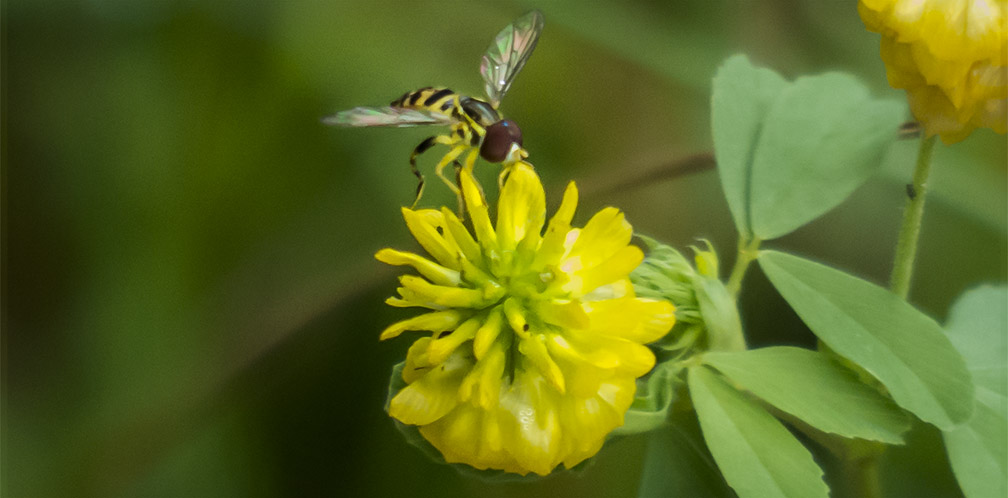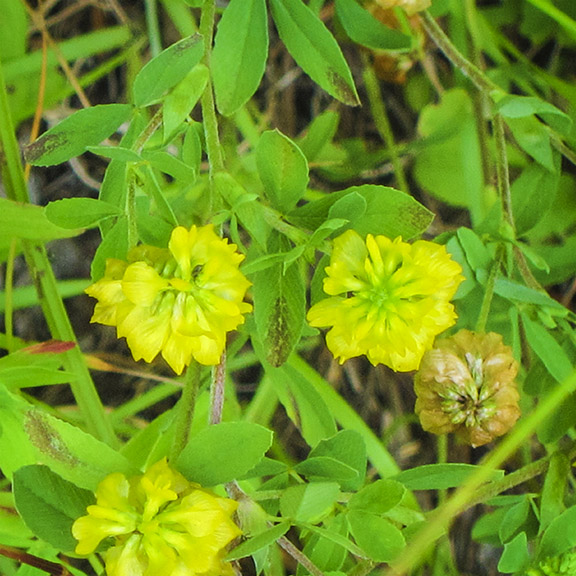Wildflowers of the Adirondacks:
Hop Clover (Trifolium aureum)

Hop Clover (Trifolium aureum) is a non-native plant which produces bright yellow flower clusters in the summer. Hop Clover is a member of the Pea family. It is also known as Golden Clover, Yellow Hop Clover, Greater Hop Clover, Large Hop Trefoil, and Palmate Hop Clover. The genus name (Trifolium) refers to the three-parted leaves. The species name (aureum) is Latin for "golden."
Hop Clover is not native to the Adirondacks or to North America. It is a Eurasian plant which was introduced in 1800 as a pasture crop. Not all introduced species are considered invasive: plants that have become serious environmental pests. In fact, some non-native species do not cause significant problems in their new environment.
Hop Clover appears to fall into the category of introduced species which do not cause drastic changes in ecology. Hop Clover appears in the Invasive Plant Atlas of the United States; and is considered invasive in Yellowstone National Park. However, this species is absent from other invasive plant lists.
- The US Department of Agriculture does not list Hop Clover as an invasive plant.
- Hop Clover does not appear on the Federal Noxious Weed List.
- Hop Clover does not appear on any of the state noxious weed lists.
- Hop Clover does not appear among the species profiles provided by the National Invasive Species Information Center.
- The New York Invasive Species Clearinghouse does not include it on its list of 183 nonnative plant species.
- Hop Clover is not listed among species of concern by the Adirondack Park Invasive Plant Program.
This material suggests that Hop Clover is not considered to be a serious environmental threat.
Identification of Hop Clover

Hop Clover grows about eight to eighteen inches high. Like all clovers, this plant has alternate leaves divided into three leaflets. Each leaflet is about 1/2 to 3/4 inch long, rounded at the tip and finely toothed. The leaflets of the Hop Clover are stalk-less, in contrast to those of a similar plant – Trifolium campestre – which has stalked leaflets.
Hop Clover has numerous flowers on branching stems. The flowers are arranged into small, elongated round head-like cluster. The clusters are 1/4 to 3/4 inch across. As they age, the flowers become a creamy color and then rusty brown and paper-like before they go to seed. Hop Clover usually blooms in the Adirondacks in mid-July, depending on the weather.
Uses of Hop Clover
Hop Clover has limited edible uses. One source suggests that this species can be used in salads or to brew tea. No medicinal uses were found.
Wildlife Value of Hop Clover
Although several other clovers that grow in our area are of value to wildlife, Hop Clover appears to have minimal use. For instance, while Red Clover is listed among the top nectar flowers for butterflies, Hop Clover (although it attracts some insects) reportedly is not effective as a nectar flower.
Distribution of Hop Clover
The plant is naturalized throughout much of eastern North America, as well as many of the western states and Alaska. It is present in over half of the counties in New York State and many counties in the Adirondack Park Blue Line.
Habitat of Hop Clover
Hop Clover grows in part shade and sun along roadsides and wider forest trails. You can also find it in successional fields (such as those at John Brown Farm), and in pastures, waste places, and disturbed areas in many locations in the Adirondack Mountains.
References
Michael Kudish. Adirondack Upland Flora: An Ecological Perspective (The Chauncy Press, 1992), p. 160.
New York Flora Association. New York Flora Atlas. Large Hop Clover. Trifolium aureum Pollich. Retrieved 14 April 2017.
United States Department of Agriculture. The Plants Database. Golden Clover. Trifolium aureum Pollich. Retrieved 14 April 2017.
NatureServe Explorer. Online Encyclopedia of Life. Trifolium aureum – Pollich. Retrieved 14 April 2017.
Connecticut Botanical Society. Hop Clover. Retrieved 14 April 2017.
eNature. Palmate Hop Clover. Trifolium aureum (Trifolium agrarium). Retrieved 14 April 2017.
Minnesota Wildflowers. Trifolium aureum (Golden Clover). Retrieved 14 April 2017.
Lawrence Newcomb. Newcomb's Wildflower Guide (Little Brown and Company, 1977), pp. 58-59.
Roger Tory Peterson and Margaret McKenny. A Field Guide to Wildflowers. Northeastern and North-central North America (Houghton Mifflin Company, 1968) pp. 150-151.
National Audubon Society. Field Guide to Wildflowers. Eastern Region. (Alfred A. Knopf, 2001), pp. 347-348.
Steven Clemants and Carol Gracie. Wildflowers in the Field and Forest: A Field Guide to the Northeastern United States (Oxford University Press, 2006), pp.184-185.
Alexander C. Martin, Herbert S. Zim, and Arnold L. Nelson. American Wildlife & Plants. A Guide to Wildlife Food Habits (Dover Publications, 1951), pp. 402-404.
John Eastman. The Book of Field and Roadside: Open-Country Weeds, Trees, and Wildflowers of Eastern North America (Stackpole Books, 2003), pp. 110-116.
Lee Allen Peterson. A Field Guide to Edible Wild Plants. Eastern and Central North America (Houghton Mifflin Company, 1977), pp. 80-81.
North American Butterfly Association. Eastern Massachusetts. Top Butterfly Nectar Flowers (Observed in Nature). Retrieved 14 April 2017.
Information on Non-native Plants
United States Department of Agriculture. List of Federal Noxious Weeds. Retrieved 14 April 2017.
United States Department of Agriculture. Composite List of Federal and State Noxious Weeds. Retrieved 14 April 2017.
National Invasive Species Information Center. Species Profiles. Retrieved 14 April 2017.
New York Invasive Species Clearinghouse. Invasiveness Assessment Scores and Ranks for 183 Nonnative Plant Species in NYS. Retrieved 14 April 2017.
Adirondack Park Invasive Plant Program. Terrestrial Invasive Plant Project. Retrieved 14 April 2017.
